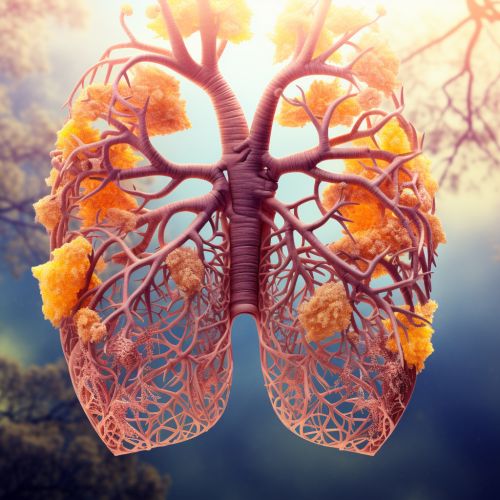Lung infection
Overview
A lung infection is a medical condition characterized by inflammation of the lung tissue due to viral, bacterial, or fungal pathogens. It is a broad term that encompasses various diseases, including pneumonia, tuberculosis, and bronchitis, among others. Lung infections can range from mild to severe, and they can affect anyone, regardless of age or health status.
Causes
Lung infections are primarily caused by microorganisms, including bacteria, viruses, and fungi. These pathogens can be inhaled into the lungs, where they can multiply and cause infection. The most common bacterial causes of lung infections include Streptococcus pneumoniae, Haemophilus influenzae, and Mycobacterium tuberculosis. Viral lung infections are often caused by influenza virus, respiratory syncytial virus, and coronaviruses. Fungal lung infections are less common and are typically caused by species such as Aspergillus, Candida, and Pneumocystis jirovecii.


Symptoms
The symptoms of a lung infection can vary depending on the specific type of infection, the individual's overall health status, and the severity of the infection. Common symptoms include cough, fever, shortness of breath, and chest pain. Other symptoms may include fatigue, loss of appetite, and weight loss. In severe cases, lung infections can lead to respiratory failure, which is a life-threatening condition that requires immediate medical attention.
Diagnosis
The diagnosis of a lung infection typically involves a combination of a physical examination, medical history, and diagnostic tests. During the physical examination, a healthcare provider may listen to the patient's lungs using a stethoscope to detect any abnormal sounds, such as crackles or wheezes, that may indicate a lung infection. Diagnostic tests may include a chest X-ray, CT scan, or MRI to visualize the lungs and detect any abnormalities. Laboratory tests, such as a sputum culture or blood culture, may also be performed to identify the specific pathogen causing the infection.
Treatment
The treatment of a lung infection depends on the specific type of infection and the severity of the symptoms. Bacterial lung infections are typically treated with antibiotics, while viral infections are usually managed with supportive care, such as rest, hydration, and over-the-counter medications to relieve symptoms. Fungal lung infections may require antifungal medications. In severe cases, hospitalization may be necessary, and some patients may require supplemental oxygen or mechanical ventilation.
Prevention
Prevention of lung infections involves a combination of personal hygiene practices, vaccination, and avoidance of risk factors. Hand hygiene, including regular handwashing with soap and water, is a key strategy for preventing the spread of many pathogens. Vaccines are available for some types of lung infections, including pneumonia and influenza. Avoiding risk factors, such as smoking and exposure to secondhand smoke, can also help to reduce the risk of developing a lung infection.
